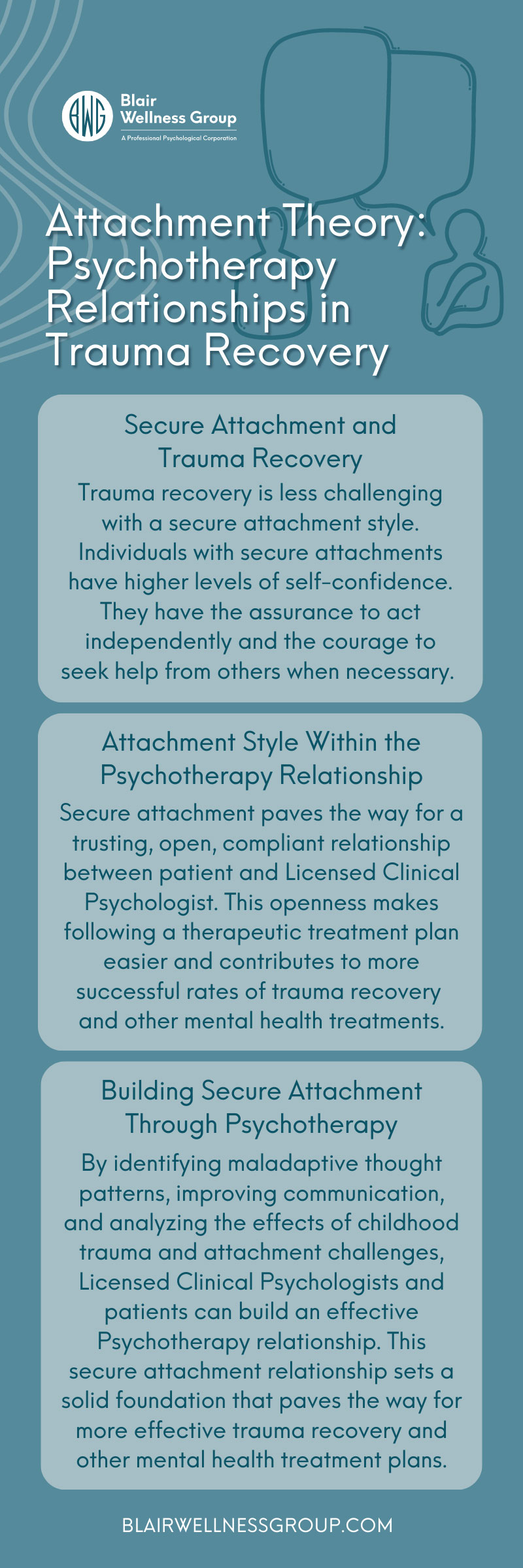Attachment theory and emotional wounds—trauma recovery are two aspects of mental health that closely intertwine. Trauma—especially childhood distress—informs your attachment style, while your attachment style informs how you react to stressful situations, unpleasant news, conflicts in intimate relationships, emotional adversities, or trauma. Furthermore, your attachment style affects how you develop skills, like emotional regulation, modulating your affect, and developing resilience in relationships, which are key traits in handling emotional distress and adversities in a healthy and effective manner.
Licensed Clinical Psychologists use their training and formal education based on the relevance of attachment theory to help clients with emotional distress, psychological health, mental wellbeing, and trauma repair. By addressing the challenges of insecure attachment in childhood and the obstacles it can present for the Psychotherapy relationship, Licensed Clinical Psychologists help their clients navigate the scars of past emotional wounds to create a renewed vision for life and intimate relationships. Learn more about the connection between attachment theory and the Psychotherapy relationship in repairing the ruptures that occurred as a result of childhood psychological wounds/emotional adversities, to restore a sense of wellbeing and emotional health in adult life and relationships.
Secure vs Insecure Attachment
You must first understand what each attachment style means and how it develops to understand the role attachment theory plays in childhood trauma recovery or any other form of mental health treatment for mood disorders, addiction issues, anger management, stress management, personality disorders, and relationship/intimacy issues. Simply put, your attachment style informs how you relate to others personally, intimately, socially, romantically, or professionally, which indicates the quality of your close and intimate relationships in adulthood.
Attachment style begins in infancy with your relationship with your parents, primary/secondary caretakers, or guardian figures. Your mind is learning whether you can rely on your primary and secondary caretakers for the most primitive needs, including timely feeding, emotional security, psychological comfort, and physical safety from the moment you are born throughout the most formative years of your life. You have a secure attachment style if the answer is yes. But you develop an insecure attachment style if the answer is no—as is the case with individuals who experience childhood trauma, including but not limited to, emotional/physical neglect, psychological adversity, verbal/physical abuse, mental/emotional adversity, sexual abuse, incest, or abandonment whether emotionally, mentally, or physically.
Secure Attachment
Secure attachments form when there is a healthy relationship between a child and their primary and secondary caregivers. Children learn to feel proper validation of their emotional, mental, and physical needs, which provides them with a healthy container and a “secure base”. This allows children to develop a healthy sense of self and proper self-esteem, which helps them navigate adult relationships adaptively and constructively. As a result, they will become confident in themselves and their relationships with others when they know they can rely on their guardians for support, protection, care, and comfort.
Children with secure attachment styles know that they have and deserve love, validation, security, safety, trust, and acceptance for their needs, thoughts, wishes, dreams, so they grow into adults who treat themselves and others with love, trust, reliability, and respect. Individuals with a secure attachment style are comfortable with both emotional and physical independence, as well as proper boundaries required for healthy, adaptive, long-lasting, and sustainable emotional intimacy. They also develop crucial skills, required to cultivate, nourish, and sustain intimate and enduring relationships. These interpersonal skills include proper emotional regulation, modulating of affect, anger/stress management, and adaptability in the face of stress or emotional adversity.
Avoidant Attachment
The other three forms of attachment—avoidant, ambivalent, and disorganized—are insecure attachment styles. Individuals with an avoidant attachment style are quick to disregard emotional and physical intimacy. They cling to strict independence because they struggle to admit vulnerability and trust those around them. As a result, many with an avoidant attachment style have a hard time getting close to people, unable to trust anyone, constantly questioning others’ motivations, unable to ask for guidance, difficulty with surrendering to any instruction or process—which prevents them from finding emotional guidance and necessary support in adulthood.
Ambivalent Attachment
Ambivalent attachment revolves around heightened sensitivity to rejection and the need for constant validation from others. Those with an ambivalent attachment style might rely too heavily on a friend, family member—particularly romantic partners—to relieve their extreme fear of rejection or abandonment. Moreover, ambivalent attachment causes people to rely on those around them for emotional regulation, stress modulation, and interpersonal skills they could not develop and practice during childhood years. This reliance on friends, intimate partners, or family members in adulthood results in codependency, emotional triangulation, improper need for constant validation/praise, and other unhealthy relationship dynamics, particularly with romantic partners and offspring.
Disorganized Attachment
Those with a disorganized attachment style deal with the challenges of both avoidant and ambivalent attachment styles. Disorganized attachment style stems from an inconsistent, unpredictable, or unreliable relationship dynamics with primary or secondary caregivers during childhood formative years. It can also develop from extreme emotional adversity, neglect, abandonment, trauma, including living with emotionally, mentally, psychologically, physically, or sexually abusive caregivers or parents. The inconsistent, unreliable, unpredictable, unnurturing relationships a child experiences when they are young lead to several contradicting struggles, such as an intense longing for emotional closeness paired with an inability to surrender to trusting relationships or be vulnerable with others in the context of intimate relationships.
Insecure Attachment, Emotional Regulation, and Trauma
Feeling unsafe, unaccepted, or overwhelmed throughout childhood can cause insecure attachment to develop. Without the comfort, stability, and safety of a secure attachment relationship, you do not develop key mental wellness and necessary interpersonal skills required to regulate emotions, modulate affect, tolerance of distress, managing difficult emotions, and the ability to properly and effectively communicate thoughts, desires, and feelings or adapt to developmental changes in life.
These skills—or lack thereof—do more than just affect your relationships as an adult. They also determine how you respond to emotional adversities, relationship conflicts, distress in interpersonal relationships, or traumas when they occur. An insecure attachment style leaves you with few skills or healthy coping mechanisms in place to handle or resolve emotional distress, volatile situations, relationship conflicts, or trauma.
As a result, you might turn to maladaptive behaviors, such as addiction to substance, alcohol, sex, gambling, porn, traveling, shopping, gaming, social media, codependent or abusive relationships, in subconscious effect to ease the distress, psychological turmoil, mental adversity, emotional wounds, or difficulties sustained by traumatic experiences. These maladaptive behaviors can lead to low self-esteem, lack of confidence, self-destructive tendencies, abusive dynamics in interpersonal relationships, addictive behaviors and tendencies, poor anger management, poor health, lack of emotional wellbeing, isolation, alienation, and other severe mental health and medical complications in later life.
Secure Attachment and Trauma Recovery
You cannot prevent trauma or traumatic events, but you can improve your mental and emotional response to unpleasant and traumatic situations or relationships. Trauma recovery involves processing negative feelings, building emotional and mental resilience by overcoming the emotional challenges and mental adversities that prevent you from feeling whole, secure, emotionally safe, mentally competent, healthy, and fulfilled.
Trauma recovery is far less challenging with a secure attachment style. Individuals with secure attachments have higher levels of self-confidence, self-esteem, and a healthy sense of self. They have the assurance to act independently and the courage to seek help from professionals when necessary. In the face of trauma, those with a secure attachment style are more likely to confront their emotional reactions honestly, regulate their conflicting thoughts and volatile feelings, and seek necessary guidance from a professional qualified to guide them in their personal endeavours.
Attachment Style Within the Psychotherapy Relationship
Your attachment style informs more than your personal relationships. It also informs your Psychotherapy relationship or the dynamic you have with your Licensed Clinical Psychologist. Insecure attachment styles create challenges—such as difficulty with open communication, transparency, alliance, rapport, responsiveness to treatment, treatment compliance, and consistent commitment to meaningful change that hinders the success of mental health treatment outcomes.
Secure attachment, on the other hand, paves the way for a trusting, open, compliant relationship between a patient and a Licensed Clinical Psychologist. This openness, alliance, transparency, truthful commitment to real change, responsiveness to treatment, forfeiting deployment of defense mechanisms, which in turn makes following a therapeutic treatment plan easier and contributes to more successful rates of trauma and mental health recovery or other mental health treatments for mood disorders, personality disorders, intimacy issues, and addictive behaviors.
Building Secure Attachment Through Psychotherapy
The connections between attachment theory, Psychotherapy relationships, and trauma recovery make it clear that developing a secure attachment style in the context of therapeutic relationship is the key to helping clients work through traumatic experiences in order to achieve their clinical objectives in a timely manner.
But what if you have an insecure attachment style? Licensed Clinical Psychologists work closely with clients to work through insecure attachment and build a secure attachment style. By identifying maladaptive thought patterns, changing associations, improving communication styles, practicing interpersonal effectiveness, and analyzing the effects of childhood development and attachment challenges, Licensed Clinical Psychologists and patients can build an effective Psychotherapy relationship. This secure attachment relationship sets a solid foundation that paves the way for more effective trauma recovery, mental health, emotional wellbeing, psychological health, fulfilling relationships, ability to develop self-confidence and self-esteem, become a healthy partner and parent.
Dr. Blair and the team at Blair Wellness Group provide Trauma Therapy in the OC. We can help, whether you want to learn more about attachment styles or take the first steps toward healing after a traumatic event. Reach out today and let Blair Wellness Group help you achieve a healthier, happier, more productive life.

Dr. Cassidy Blair is a renowned Licensed Clinical Psychologist and trusted Performance Coach who specializes in providing Concierge-Psychological Care and Executive Coaching for high-achieving professionals. With a deep understanding of the unique challenges faced by CEOs, executives, entrepreneurs, and leaders, Dr. Blair offers tailored, confidential care designed to foster emotional well-being, personal growth, and professional excellence. Her clientele values her discretion, clinical expertise, and emotionally intelligent approach to navigating complex personal and professional dynamics.
- This author does not have any more posts.




